Divisional Charts
The classic Brihat Parasara Hora Sastra provides useful hints to an important question that should trouble astrologers with rational thinking – “Why are there so many twins in this world who have the same Rasi chart and possibly the same Navamsa chart, but significantly different lives”.
Parasara has defined divisional charts and expounded the matters to be seen from each divisional chart, right after he defines the nature of planets and the nature of signs and before he elucidates the results of various houses.
It indicates that Parasara considers the divisional charts to be as basic an ingredient in the scheme of Jyotisha as the planets, signs and houses. It is evident that he considers these four to be the four dimensions of Jyotisha.
After stating that education may be seen in the Chaturvimsamsa chart and that vehicles may be studied-from the Shodasamsa, for example, Parasara indicates that the 4th house stands for education and vehicles. It seems logical to think that he means that the 4th house in Chaturvimsamsa stands for education and learning and the 4th house in Shodasamsa stands for vehicles. Unless Parasara had meant houses and divisional charts to be two separate dimensions, he would not have assigned the same matter to a house and to a divisional chart. This suggests that he considered the 4th houses in various divisional charts, for example, to be the variations of the same house. When he says “4th house” in the rest of the discourse, he could have meant any variation, i.e., 4th house in any divisional chart, with the correct variation inferred from the nature of the matter at hand and the divisional chart relevant to that matter.
Another factor favouring the above notion is that he has defined divisional charts while replying to Maitreya’s query:
Srutaa graha gunaastwattastathaa
raasi gunaana mune
Srotumichchhaami bhaavanaam
bhedaanstaan kripayaa vada
O Sage! I have heard from you the nature of planets and the nature of signs. I want to hear about the different kinds of houses. Kindly explain them to me.
By answering the question on the “variations of houses” with the definition of 16 divisional charts, Parasara may have implied that the houses in the 16 divisional charts are the different kinds of houses. For example: There are 16 different 4th houses – (1) 4th house in Rasi (2) 4th house in Navamsa (3) 4th house in Dasamsa etc. When Parasara says “4th house” in the rest of the discourse, he would not have to clarify which variation he meant, for he has listed the matters to be judged from various divisional charts prior to listing the results of houses.
Once it is accepted that each divisional chart has its own houses and it should be analysed for insight into certain matters, new avenues are opened for astrological analysis. Astrology can then attempt to address the “twins question” in a systematic manner. For example, this scribe came across the charts of twin brothers of whom the elder one was brilliant at studies and the younger one was a mediocre student. Though both have the same Rasi chart, they have different Ascendants in the Chaturvimsamsa. the chart for education. In the Chaturvimsamsa. the elder one has Ascendant lord Venus is a trine in Gemini, a Mercurian sign, with Mercury situated in the 5th, aspected by the 5th lord, while the younger one has both the Ascendent lord and the 5th lord, debilitated. Moreover, the elder one has the Moon and Jupiter in the 4th, aspected by Mars and he studied commerce and accounting. The younger one was good at mathematics despite poor marks in all other subjects and he has Mercury in the 4th. Thus analyzing the relevant divisional chart offers a finer insight than studying the Rasi chart alone and the former approach can offer convincing explanation in the case of twins with significantly different lives.
Each planet represents various forces in action in each human experience. Each Rasi represents various fundamental angles of human experience and action. Each house represents various matters of relevance in human beings. Each divisional chart represents various matters focused on a particular sphere of human experience (e.g., fortune and assets, parents, learning and intellect, children, siblings etc.) These four dimensions together uniquely represent human life. Of the various matters attributed to each house, matters relevant to the sphere of human experience represented by the divisional chart under study have to be considered. For example the 6th in Navamsa may represent quarrels in marital life, the 6th house in Chaturtamsa may represent litigation involving property and the 6th in Dasamsa may represent rivals in profession.
2. Computaion of Nakshatramsas
Divisional charts like the Saptama, Dasamsa and Dwadasamsa are widely employed by contemporary astrological savants but some higher divisional charts seem to be rarely utilised. Nakshatramsa chart is one such chart.
Nakshatramsa is also called Bhamsa or Saptavimsamsa. Each rasi is divided into 27 equal parts and Nakhathramsa corresponding to these 27 parts extend from Aries , cancer, Libra or Capricorn depending on whether the rasi is fiery, earthy, airy, watery sign respectively.
Nor example, let us suppose that a planet (or Ascendant) is at 22 degree 7minutes Aquarius . Aquarius is an airy sign and so we must start counting from Libra. Each nakshatramsa is 30/27 degrees and hence the 20th Nakshatramsa extends from 21degree 6min 67sec to 22degree 13min 33sec. Counting the 20th house from Libra, we get Taurus. I shall refer to the Nakshatramsa chart as D-27 henceforth.
3. Significations of Nakshatramsa
Purasara has said,
Bhaamse chaiva balaabalam
One’s strengths and weaknesses should be judged from D-27.
A question that usually strikes the curious readers could be regarding the accuracy of the data used. Higher divisional charts are very sensitive to birth-time errors. The Ascendant in D-27 changes sign once every 4.44 minutes, on the average. So we cannot be confident that the Ascendant evaluated using the reported birth-time is always correct.
I have considered Kalachakra Dasa, which typically changes by 3 months if birth-time changes by 1 minute. Using it along with Yogini Dasa (See (1), (6) and (7) and Vimshottari Dasa (See 1) with several divisional charts, I was able to rectify reported birth-times finely, based on known events.
The consistent theme found in these studies is that D-27 highlights the salient features of one’s nature and offers insights into one’s personality, inherent strengths and weaknesses. It is a better indicator than even the Rasi chart, when it comes to studying one’s ‘ inherent nature and tendencies.
4. Analysis of Nakshatramsa
D-27 should be analysed just like the Rasi chart. Each Rasi is a house. Houses can be counted from the Ascendent or the Moon or the Ghati Lagna. Concepts like planetary aspects, sign aspects, Yogas and Argalas etc., work just like in the Rasi chart. However, the sphere of human experience represented by this chart is one’s inherent nature and of all the meanings of various houses, meanings consistent with this should be considered. For example, the 9th house does not stand for father or fortune in foreign lands or teacher or the 3rd child or wife’s younger brother. It rather stands for generosity (Datrittwa).
We should judge the interactions between planets, Rasis and houses in D-27 just like in the Rasi chart. If the 7th lord is in the 6th aspected by Mars for example, it may suggest lack of diplomacy and tendency to get involved in quarrels. If the Ascendant lord is exalted with the Moon and Jupiter in the 4th, it may suggest an excellent level pf peace of mind.
To give a real-life example, Albert Gore Jr4., a past Vice President of the USA, has the Ascendant and Mars in Scorpio and the Sun in the 7th in D-27. Ruchaka Yoga in Scorpio may have made him aggressive, ambitious, somewhat secretive and always pursuing loftier goals. It may have even given him some kind of aloofness5. The sign crucial to his pro-active and enterprising nature Scorpio has the 5th house and Yogakaraka Mars in Dasama and thus his pro-active nature has been put to good use in his career.
Just as the links between various houses are analysed, the links between various divisional charts may also be analysed. Planets and signs act as links between charts and house. For example, a native has an afflicted Sun in D-27 in Pisces which indicates some egotism. He has the 6th house in Pisces in Dasamsa. the chart of profession. He is very nice to others, but he is very egoistic and arrogant when dealing with his professional rivals.
If there are signs’or planets that show strong influences that are not consistent with the overall theme of the rest of the chart, corresponding changes in attitude may be observed during the Dasas of those planets and signs. Especially potent are Dasas pertaining to benefic planets that are particularly afflicted and the Nodes. It is observed that Kalachakra Dasa gives the best results.
Chart 1: Born November, 1970 at 16 h.06 m (IST) respectively at 30 N 44, 76 E 53
5. Practical Illustrations
Twins-Satyam and Shivam:
Facts: Satyam is very optimistic and has a jovial and amicable disposition. Shivam, on the other hand, is somber and serious. He is a skeptic and has little belief in astrology and such other disciplines.
Satyam : Chart 1 gives D-27. It must be noted that Satyam’s D-27 has Ascendant lord Mercury in the Ascendant, causing a powerful Bhadra Yoga. Mercury is in Jupiter’s Nakshatra. and in a Venusian sign in the Rasi chart and unafflicted in D-27. Thus Bhadra Yoga is powerfully operative in his D-27. This can bless him with optimism and a jovial and amicable disposition. The Moolatrikona is also indicative of such attitudes. Venus also occupies a constellation of Jupiter. The Moon has Neechabhanga. Mercury’s strong influence can cause him to be always happy, helpful to relatives and respect tradition. With the 7th lord in D-27 Jupiter, being in own constellation and Venusian sign, both in Rasi and D-27, he is diplomatic and compassionate.
Shivam: On the other hand, the Ascendant in Shivam’s D-27 is Cancer and the Ascendant lord is debilitated, aspected by the 6th lord. The lord of the 5th and the dispositor of the Ascendant lord, Mars is afflicted by Ketu and he is in mutual aspect with the 7th and 8th lord Saturn. This suggests a serious person in whom a curious mixture of gloom and anger resides. The situation of the 8th lord Saturn and Rahu in the 9th in an aspect with the 5th lord indicates skepticism and it makes sense that he does not believe in astrology. With the 7th lord in D-27, Saturn, being with Rahu aspected by Mars, he may be brash and lack the diplomacy of Satyam.
An Indian Engineer in the USA
Facts: The native of Chart 2 is extremely generous, righteous and noble. He is a dynamic person and comes across as an intellectual. He is diplomatic, but when under pressure, he can turn a little harsh. He turned somewhat pessimistic and angry later on in life, when he experienced very harsh events and those he trusted deceived him and nearly destroyed his life.
Chart 2 gives his D-27. The Ascendant in Aries suggests dynamism. Mercury, the 3rd lord, is in the Ascendant. The lord of the 9th and 12th Jupiter is exalted in a quadrant without any afflictions, giving rise to a powerful Hamsa Yoga and causing Argala on the Ascendant (See 3). So he is very generous, compassionate, righteous and noble, with the 7th house falling in Libra and with a diplomatic nature. However, with the 6th lord occupying the Ascendant in a fiery sign, with Rahu occupying the 2nd and with the 7th lord Venus joining Mars in a Saturnine sign, with Argala from Saturn and Rahu, he is capable of acting in a brazen manner at times. The Sun in the 6th aspected by Saturn suggests proneness to quarrels with authorities. The 2nd house stands for one’s manners. It is Taurus here and it is occupied by Rahu, who also causes Argala to its lord Venus in Aquarius. The 6th house Virgo has the Sun in it and Saturn aspecting it and its lord is in the Ascendant. The said change in his behavior took place during the Bhukti of Virgo in the Dasa of Taurus as per Kalachakra Dasa. Rahu’s Yogini Dasa was running then. The correlations here are interesting.
Bill Clinton
Chart 4: Bill Clinton: Born August 19, 1946 at 8 h. 53 m (6 hours behind GST) at 33 N 40, 93 W 46.
Facts: Clinton comes across as a smart and intelligent person. He is charming and ambitious. He recently “repented” for the “sin” of “misleading” and “letting down” his nation and family on a scandal.
There is a Yoga called Asatyavadi Yoga that comes into effect when the 5th lord is in a sign owned by Mars of Saturn. If primarily Mercury and secondarily, the Ascendant lord and the Moon also occupy such signs, the indications become more intense. Chart 3 may be found to satisfy these criteria. The situation of the Ascendant lord in a Saturnine sign and mutual aspect between Mars in the Ascendant and Saturn may indicate selfishness and aggression.
Despite the 5th lord in a Dustana, aspected by Saturn, and the situation of Ketu in the 5th, Jupiter in the 5th acts as a stabilizing factor as far as emotional stability is concerned.
The 7th lord Jupiter in Libra with an aspect from the 2nd lord Moon suggests diplomatic knack. Venus in Scorpio in the 6th may give him susceptibility to sexual scandals. Interestingly, be was running the Bhukti of Scorpio in 1999 as per Kalachakra Dasa.
An Egoist
Facts: The native is well-known for his achievements in some circles. He lacks diplomacy and he is highly egoistic and self-centered in his social behaviour. But he is religiously inclined.
Chart 4 gives his D-27. The Ascendant contains the Sun who is afflicted by Ketu, Jupiter’s aspect is a saving grace, but Jupiter is a functional malefic. The affliction to the Sun in the Ascendant may make him an egoistic person. Mars is the 12th lord and he is debilitated. So the native lacks humility. The debilitation of the 7th lord and situation of the 8th lord and Rahu in the 7th indicate harsh behaviour and lack of diplomacy. The Moon in a fiery sign, affliction of the 4th lord Sun by Ketu and affliction of the Moon’s dispositor by Rahu in the 12th house from the Moon indicate mental peace may be lacking to a large degree.
On the positive side, the Ascendant lord Venus, Yogakaraka Saturn and the 2nd and 5th lord Mercury in the 9th house form an array of brilliant Yogas. The 10th house falls in the Moolatrikona of the strongest planet in this Yoga, Saturn, and this has paved the way for his good social standing. This Yoga has also blessed him with religious piety, despite the drawbacks of ego.
6. Conclusion
I believe that Parasara considered divisional charts to be as basic an ingredient in the scheme of Jyotisha as are planets, signs and houses. Nakshatramsa, which is not widely employed by contemporary astrologers has been found to shed light on one’s nature, attitude, inherent strengths and weaknesses. Some examples substantiating these observations been presented in this paper. It is hoped learned readers will develop further on these findings and use them for the betterment of the world.
Courtesy: Modern Astrology(P.V.R. Narasimha Rao)



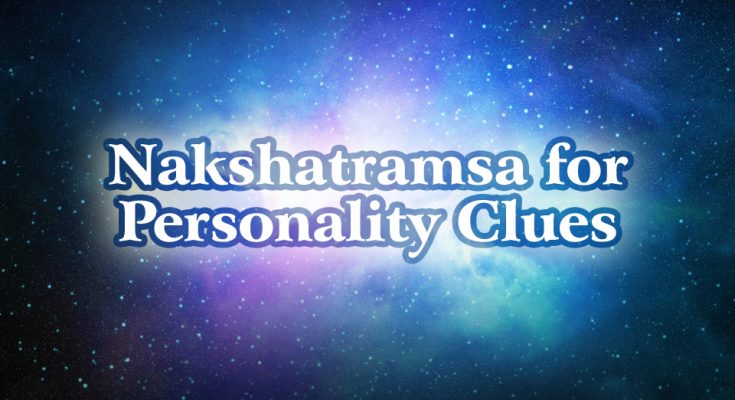
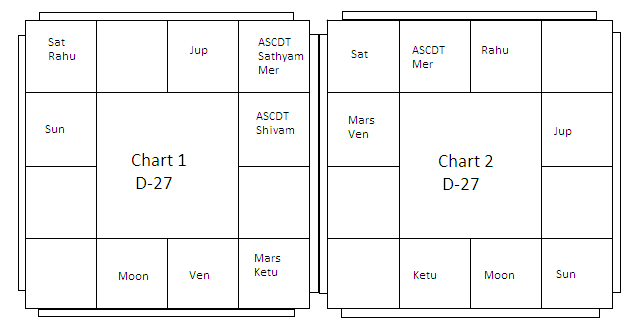
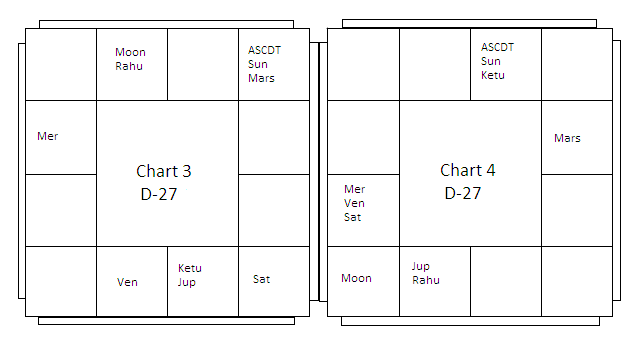
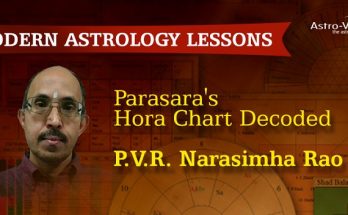
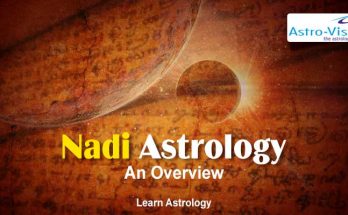
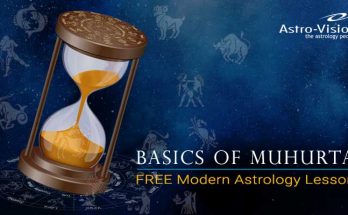

2 Comments on “Nakshatramsa for Personality Clues”